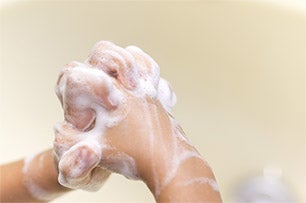
There is no getting around: we are in the throes of flu season. You may already have a friend or family member who has come down with something unpleasant by now. It can be hard to avoid getting sick, but proper hand washing and other hygiene techniques can help prevent the spread of the flu from one person to another. This is why Lovelace Health System sponsors the “Don’t Bug Me” campaign.
The Don’t Bug Me campaign is about teaching elementary school students how to prevent the spread of the flu simply by using proper hand washing techniques and habits for covering the mouth and nose when coughing or sneezing. Over the years, Lovelace has presented this campaign at several elementary schools throughout the area with demonstrations, t-shirts and posters promoting this fun and healthy campaign.
Children who know how to wash their hands can help prevent bringing germs home to their families. They can also remind their parents to wash their hands, too.
Even though disease prevention education needs to begin early, adults occasionally need reminders of the dangers of germs and their spread as well. Here are some easy-to-follow reminders of when we need to wash our hands to prevent the spread of disease.
Wash your hands:
- During, before and after preparing meals. Pay particular attention to this habit when handling meats of any kind.
- After sneezing and coughing, even if you use a tissue. Germs that come from a cough or a sneeze can spread hard and fast, take the extra precaution and wash your hands immediately after wards.
- Before eating.
- After using the bathroom, every time, even if it‘s just to grab a tissue.
- After handling animals, pet food or their excrement.
- After touching body parts that may not be cleansed.
- After handling garbage, public phones or several handshakes.
To properly wash your hands, follow these easy steps:
- Apply soap just after running your hands in water.
- Rub your soapy hands together for approximately 20 seconds while giving care between your finger nails.
- Rinse and dry off with a clean towel or air dry if you prefer.
- If hand washing isn’t readily available, you can use hand sanitizers or alcohol-based wipes.
- It’s also a good idea to remember that when you cough or sneeze, use a tissue rather than your hands, and throw the tissue away. If there aren’t tissues available, coughing or sneezing into your elbow is a much better option than your hands.
Let’s all set a good example for our young ones by taking good care of our hands and practicing good habits while we cough and sneeze. We can all help prevent the spread of the flu this season.




